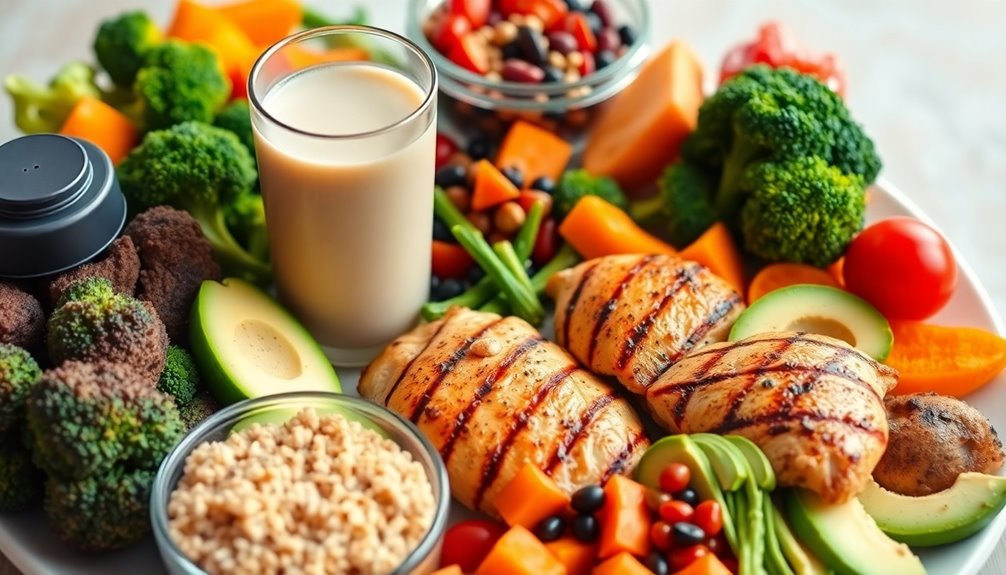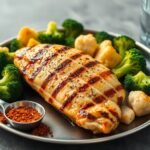The Anabolic Diet is a strategic approach to nutrition aimed at boosting muscle growth while minimizing fat gain. You'll focus on manipulating macronutrient ratios, cycling between low-carb and high-carb phases. This diet emphasizes high-quality protein, healthy fats, and complex carbohydrates, while steering clear of processed sugars and trans fats. By planning your meals and prepping in advance, you can maintain consistency and balance your energy levels. The benefits include better hormone balance and improved liver health. With the right tips and food choices, you'll maximize your results. There's plenty more to explore about this effective diet plan!
Key Takeaways
- The Anabolic Diet focuses on strategic macronutrient manipulation to promote muscle growth while supporting fat loss.
- It includes alternating low-carb and high-carb phases to optimize energy levels and hormone balance.
- Recommended foods include lean proteins, healthy fats, complex carbohydrates, and a variety of vegetables for overall nutrition.
- Meal planning and preparation are essential for maintaining targeted macronutrient ratios and supporting workout performance.
- Consistency in following the diet and integrating it with workout routines is crucial for achieving desired fitness results.
Overview of the Anabolic Diet
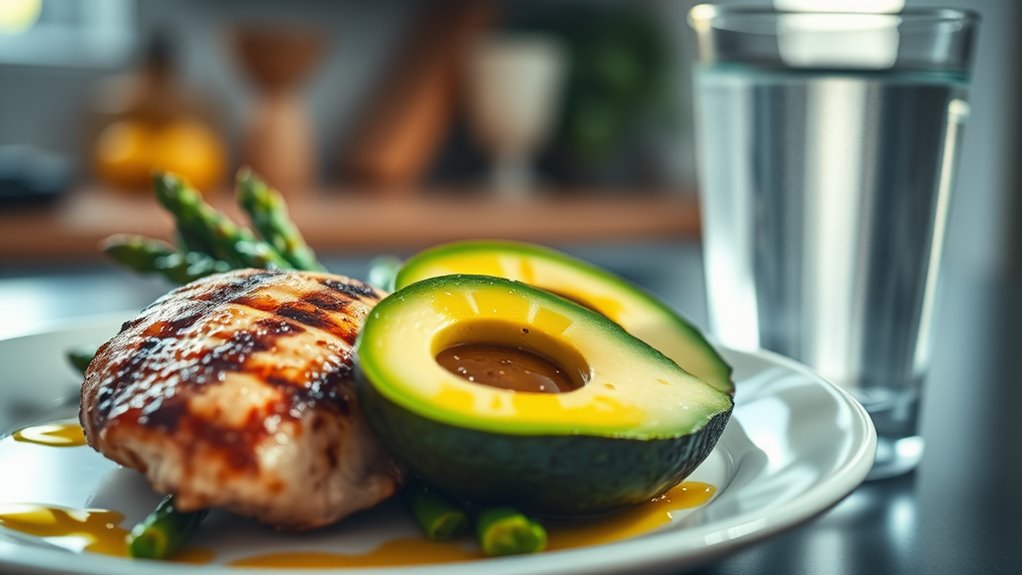
The anabolic diet's main principle revolves around manipulating macronutrient intake to promote muscle growth while minimizing fat gain. By focusing on specific macronutrient ratios, you can create a dietary framework that supports your fitness goals. It's all about finding the right balance between proteins, fats, and carbohydrates. This isn't just about counting calories; it's about strategically selecting foods that work harmoniously together.
Meal planning becomes vital in this approach. You'll want to organize your meals to make sure you're hitting your targeted macronutrient ratios consistently. Think of it as sculpting your diet just like you'd your physique. Planning your meals ahead can help you avoid the pitfalls of impulse eating and keep you on track.
You might find it helpful to incorporate lean proteins, healthy fats, and complex carbohydrates into your meals. For instance, consider grilled chicken with quinoa and a side of vegetables. This combination not only satisfies your hunger but also provides the nutrients your body craves for recovery and growth. Additionally, understanding the benefits of ketosis and metabolic processes can further enhance your dietary approach.
As you dive deeper into the anabolic diet, you'll recognize how important it's to stay connected with others who share your passion. Joining a community can offer support and accountability, making your meal planning journey even more enjoyable. By embracing the anabolic diet, you're not just fueling your body; you're also fostering a sense of belonging in a community that values strength and health.
Key Principles and Phases
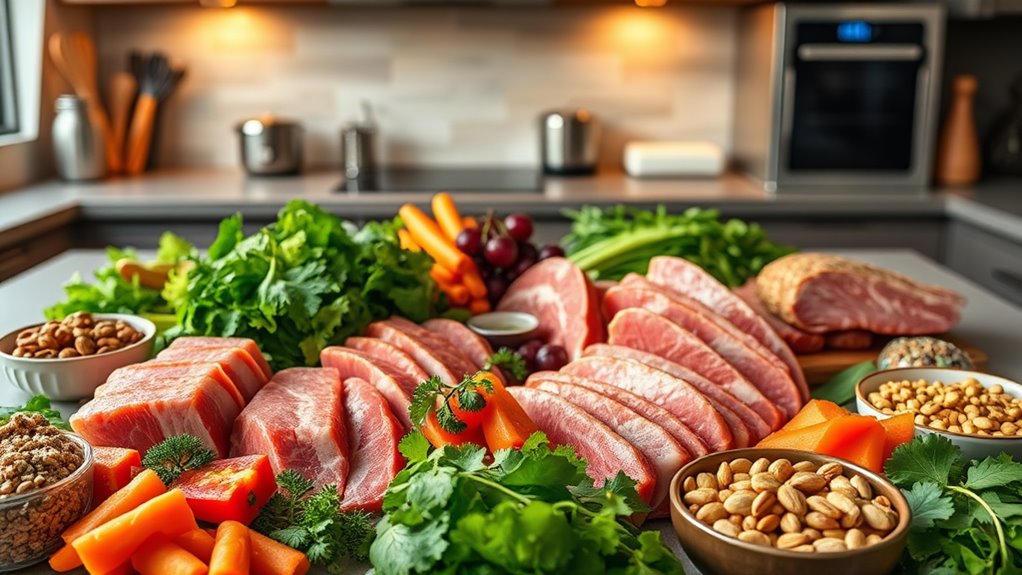
Understanding the key principles and stages of the anabolic diet can greatly enhance your muscle-building efforts. This diet revolves around strategic meal planning and precise macronutrient ratios to help you maximize muscle gain while minimizing fat accumulation. It's all about creating an environment in your body that fosters growth.
The anabolic diet typically consists of two main phases: the low-carb phase and the high-carb phase. During the low-carb phase, you focus on reducing carbohydrate intake, which helps your body tap into fat stores for energy while promoting fat loss. This phase usually lasts around five to six days. You'll want to concentrate on high-quality protein sources and healthy fats, ensuring your meals are nutrient-dense.
Once you've completed the low-carb phase, you progress to the high-carb phase. This phase is pivotal for replenishing glycogen stores and fueling your workouts. You'll increase your carbohydrate intake substantially, often consuming it on a single day each week. This isn't just about indulgence; it's about strategically timing your carbs to support muscle recovery and growth.
Maintaining the right macronutrient ratios throughout both phases is essential. Aim for a balance of proteins, fats, and carbs that aligns with your fitness goals. By mastering meal planning and understanding these stages, you're setting yourself up for success on the anabolic diet. Remember, you're not alone on this journey—many are walking the same path, and sharing experiences can make the process even more fulfilling. Additionally, understanding natural calorie cycles can further optimize your results by aligning your eating patterns with your body's needs.
Benefits of the Anabolic Diet
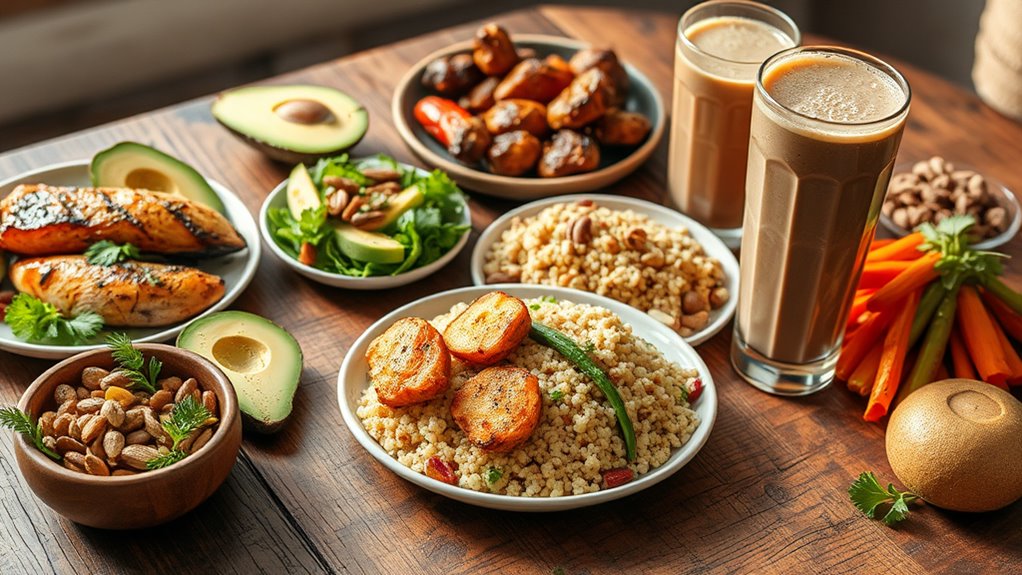
Embracing the anabolic diet offers numerous benefits that can elevate your fitness journey. One of the standout advantages is its ability to promote muscle growth while effectively supporting fat loss. By strategically cycling between high and low carbohydrate intake, you'll stimulate muscle protein synthesis and create an environment conducive to building lean mass. This approach not only helps you look great but also enhances your self-confidence as you achieve your goals.
In addition to muscle development, many people find that their energy levels soar on the anabolic diet. The balanced nutrient intake ensures your body has the fuel it needs to power through workouts and daily activities. You'll feel more energized and motivated to tackle those challenging sessions at the gym, making it easier to stay on track with your fitness plan.
Another critical benefit is the positive impact on hormone balance. The dietary structure can help regulate hormones like insulin and testosterone, both of which play essential roles in muscle retention and fat burning. When your hormones are balanced, you're better equipped to manage stress, mood, and overall well-being. Additionally, maintaining a healthy liver is crucial as it supports over 500 functions, which can further enhance your overall health and fitness results.
Joining a community that embraces the anabolic diet can amplify these benefits even further. Sharing experiences, tips, and successes with like-minded individuals fosters a sense of belonging and accountability. So, if you're ready to unleash your full potential, the anabolic diet might just be the key to transforming not only your body but also your lifestyle.
Foods to Include and Avoid
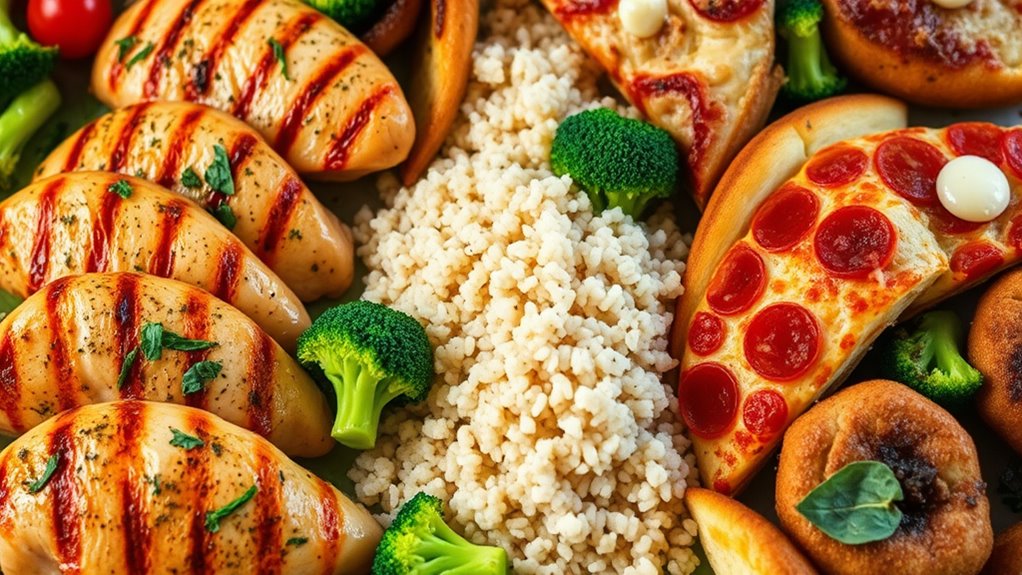
Foods to Include:
- Lean Proteins: Chicken, turkey, fish, and lean beef are essential for muscle repair and growth.
- Healthy Fats: Avocados, nuts, and olive oil support hormone production and overall health.
- Complex Carbohydrates: Brown rice, quinoa, and sweet potatoes provide the energy you need for those intense workouts.
- Vegetables: Leafy greens and colorful veggies are packed with vitamins and minerals that assist recovery and performance.
Foods to Avoid:
- Processed Sugars: Sweet treats and sodas can spike insulin levels, which isn't ideal for muscle growth.
- Trans Fats: Found in many fried and packaged foods, these can hinder your progress.
- Refined Carbs: White bread and pastries provide empty calories that don't fuel your workouts.
- Excessive Alcohol: It can disrupt your recovery and negatively affect your performance.
Incorporating whole-food sources of protein is vital for supporting muscle recovery and growth, as these options are healthier than relying on protein powders.
Tips for Successful Implementation
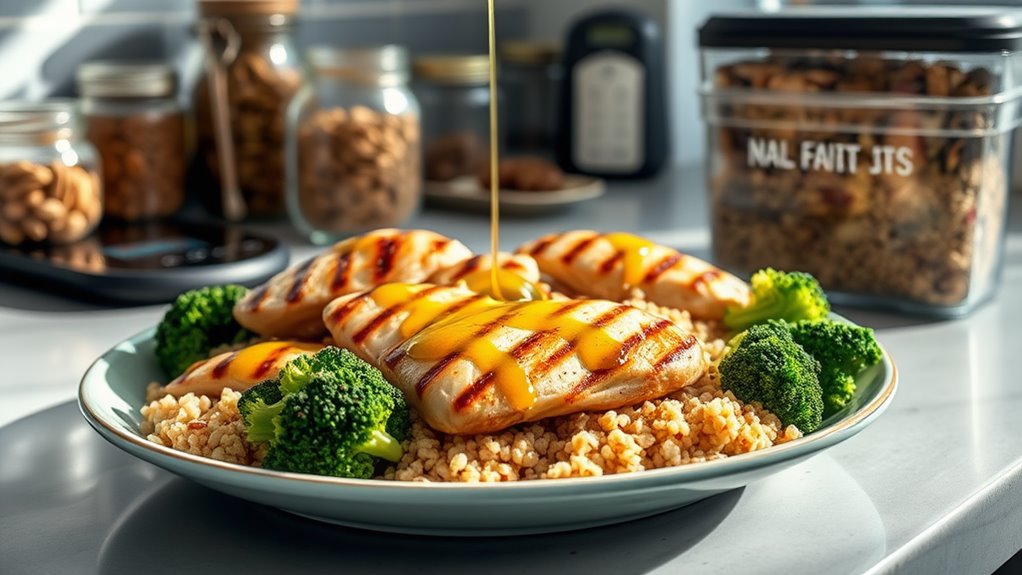
Successfully implementing an anabolic diet goes beyond just knowing what to eat; it requires a strategic approach to meal planning and consistency. You'll need to align your meals with your workout routine to maximize muscle gain and fat loss. Here are some tips to help you stay on track and feel connected to your goals.
- Meal Planning: Set aside time each week to plan your meals. This helps you avoid last-minute unhealthy choices and guarantees you have the right foods on hand.
- Prep Ahead: Cook in batches and portion out your meals. This not only saves time but also keeps you from veering off course during busy days.
- Tune into your workouts: Tailor your meals around your workout routine. Fuel up with carbs before and protein after your workouts to boost recovery and muscle growth.
- Stay Consistent: Consistency is crucial. Track your meals and workouts to identify patterns and areas for improvement. Additionally, remember that strong glutes can enhance your overall body performance and support your anabolic diet goals.
Here's a helpful table to guide your meal planning:
| Meal Type | Suggested Foods |
|---|---|
| Pre-Workout | Oatmeal, banana |
| Post-Workout | Protein shake, chicken |
| Snacks | Greek yogurt, nuts |
| Main Meals | Lean meats, veggies
Frequently Asked Questions
Can the Anabolic Diet Help With Muscle Recovery After Workouts?
Yes, meal timing plays an essential role in muscle recovery after workouts. By consuming protein sources like chicken, fish, or plant-based alternatives within the right time frame, you can maximize effectiveness.
It's important to focus on getting enough protein to repair muscle fibers and support growth. So, whether you're a meat lover or prefer vegetarian options, timing your meals right can really boost your recovery and help you feel part of a supportive community.
Is the Anabolic Diet Suitable for Vegetarians or Vegans?
If you're a vegetarian or vegan, you can definitely adapt your diet to include plant-based protein sources. Focus on legumes, tofu, tempeh, and quinoa to meet your protein needs while ensuring you're getting a variety of nutrients.
Don't forget about nutrient absorption! Pairing these proteins with healthy fats and vitamin C-rich foods can enhance absorption.
With some planning, you can create meals that fuel your body and align with your dietary choices.
How Does the Anabolic Diet Affect Metabolism?
When you follow a specific diet, it can greatly impact your metabolism. By focusing on hormone regulation, you help optimize nutrient partitioning, allowing your body to use nutrients more efficiently. This can enhance your energy levels, making you feel more energetic throughout the day.
As you support your metabolism, you'll likely notice improvements in muscle growth and fat loss, helping you achieve your health goals and feel a sense of belonging in your fitness journey.
Can I Drink Alcohol While Following the Anabolic Diet?
Drinking alcohol while on a diet can feel like walking a tightrope—there's a balance to maintain. Alcohol consumption can disrupt your hydration balance, making it tricky to stay on track.
While you don't need strict restrictions, moderation is key. A drink here and there won't derail your progress, but be mindful of how it affects your energy and recovery.
Enjoying social occasions is important, so find a balance that works for you!
What Are Common Challenges Faced on the Anabolic Diet?
When you're following a strict diet, you'll likely face common challenges like managing cravings and maneuvering social events.
Cravings can hit hard, especially when you see others enjoying indulgent foods. Plus, social gatherings might tempt you to stray from your plan.
To stay on track, focus on finding satisfying alternatives and plan ahead for events. Connecting with like-minded friends can also help you feel supported and less isolated on your journey.
Conclusion
To sum up, the anabolic diet can be a potent tool for building muscle and enhancing your physique. Did you know that studies demonstrate individuals following this diet can experience up to a 30% increase in muscle mass within just a few months? By concentrating on the right foods and adhering to the key principles, you can optimize your results. So, give it a try and see how it transforms your fitness journey!

